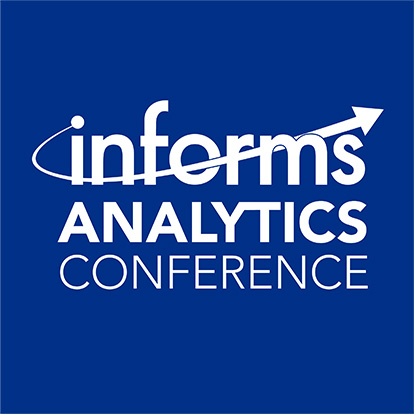Join the conference exhibitors as they discuss innovations and best practices in the field. Technology Showcase presentations are educational, feature case studies, and may use exhibitor products and services.
Professional Development Units (PDUs) are available to those who attend these sessions.
Descriptions and times below:
Monday, April 15
Time:
9:10-10am
Location:
Windsong 2

Alternative Approaches for Complex Scheduling Problems
Presented by: Robert Randall, PhD
We will look at two alternatives to traditional MIP formulations for complex scheduling problems. The first is to create code that can create feasible options for assets to schedule tasks, and then solve a simple MIP to pick the best options for each asset to cover all the tasks. The second is Constraint Programming (CP), which can be used to find good (near optimal) schedules for some very complex scheduling problems.
Time:
9:10-10am
Location:
Windsong 1

Building and Solving Optimization Models with SAS
Presented by: Rob Pratt
SAS offers extensive analytic capabilities, including machine learning, deep learning, natural language processing, statistical analysis, optimization, and simulation. SAS analytic functionality is also available through the open, cloud-enabled design of SAS® Viya®. You can program in SAS or in other languages – Python, Lua, Java, and R. SAS Analytics is also equipped with AI-enabled automations and modern low-code or no-code user interfaces that democratize data science usage in your organization and offer unparalleled speed to value.
OPTMODEL from SAS provides a powerful and intuitive algebraic optimization modeling language and unified support for building and solving LP, MILP, QP, conic, NLP, constraint programming, network-oriented, and black-box models. This showcase will include an overview of the optimization capabilities and demonstrate recently added features.
Time:
10:30-11:20am
Location:
Windsong 2

Model-Based Quantification of the Benefits and Costs of Developing a Canadian Hydrogen Network
Presented by Carlyle Deligny
In the context of the energy transition and the shift towards low-carbon systems, Artelys has conducted several studies in North America, leveraging its power system modeling tool Artelys Crystal Super Grid.
This Technology Showcase will introduce H2Clip, an ongoing research and development project focused on modeling the Canadian power system hydrogen potential. The primary objective of this endeavor is to project the evolution of the Canadian electrical system up to 2035 and assess the potential role of hydrogen within it. The presentation will delve into the development of a tool for conducting Hydrogen Infrastructure Cost-Benefit Analysis (CBA). This tool, designed to analyze various use cases, will serve as proof-of-concept for the development of hydrogen infrastructure. It will offer a diverse range of parameters and assets for investment consideration, enabling a detailed representation of specific projects.
Through this session, we aim to showcase the innovative approach of H2Clip in exploring and modeling the integration of hydrogen within the Canadian power system and its potential implications for the energy landscape.
Time:
10:30-11:20am
Location:
Windsong 1

DecisionOps, Decision Science, Open Source, Model Collaboration: Bringing It All Together
Presented by: Ryan O’Neil
Machine learning has MLOps and tools like Hugging Face. Software development has DevOps and tools like GitHub. What about operations research and decision science? That’s where DecisionOps and Nextmv come into play.
DecisionOps involves processes and tooling that accelerate the real-world impact of decision science models. It provides the deployment infrastructure, historical and online testing tools, CI/CD integration, and model management and collaboration capabilities that help decision science teams move faster and with more confidence.
Join this session to learn about these concepts, understand how they apply to your workflow, and see a live optimization speedrun of DecisionOps in action. This session will show you how to build, test, deploy decision models faster if you build using Pyomo, OR-Tools, HiGHS, Nextroute, or another optimization solution.
Time:
11:30am-12:20pm
Location:
Windsong 1

Explaining Model Predictions in Python
Presented by: Matt Bezdek, PhD
The predictive models that perform best in business use cases are not always those that provide simple explanations for why they produce a given prediction. This opacity can create barriers to trust and adoption, even if a model is accurate and efficient. In this hands-on workshop, we will cover several methods for generating clear explanations for complex models as well as how to create and interpret visualizations for model explanations. These methods work on many different types of predictive computational models and generalize to many business use cases. With practical experience in generating model explanations, you will be equipped to build trust in the results of your models and improve business decision-making.
Time:
1:50-2:40pm
Location:
Windsong 2

Unlocking Profits: Gurobi’s Price Optimization Tutorial
Presented by: Jue Xue
This tutorial will explore how mathematical optimization is an invaluable tool to enhance decision-making and how it works seamlessly with machine learning to help problem solvers get the most out of their trained predictive models. In this session, we will deliver:
- A brief introduction to math optimization and its use cases.
- A new modeling example in action that truly takes you from data to optimal decisions.
- An example from Gurobi’s set of ready-to-solve models
We’ll then wrap up by showcasing the valuable training materials Gurobi has available for anyone to use. Don’t miss out – let’s dive into the world of data-driven decision-making together.
Time:
1:50-2:40pm
Location:
Windsong 1

JMP Pro for End-to-End Business Analytics
Presented by: Ross Metusalem
JMP Pro is interactive, no-code desktop software for data visualization, statistical analysis, and predictive modeling. This technology showcase will demonstrate a range of JMP Pro’s capabilities in these areas, including Graph Builder for drag-and-drop graphing, several interactive platforms for statistical modeling and machine learning, and Text Explorer for text mining, including topic analysis and sentiment analysis. We’ll also highlight capabilities for data import and preparation and for reproducibility and reporting to underscore JMP Pro’s position as an end-to-end business analytics tool.
Time:
3:40-4:30pm
Location:
Windsong 2

Python and AMPL: Build Prescriptive Analytics Applications Quickly with amplpy, Pandas, Streamlit — and AI
Presented by: Filipe Brandão and Robert Fourer
Python and its vast ecosystem are great for data pre-processing, solution analysis, and visualization, but Python’s design as a general-purpose programming language makes it less than ideal for expressing the complex optimization problems typical of prescriptive analytics. AMPL is a declarative language that is designed for describing optimization problems and that integrates naturally with Python.
In this presentation, you’ll learn how the combination of AMPL modeling with Python environments and tools has made optimization software more natural to use, faster to run, and easier to integrate with enterprise systems. Following a quick introduction to model-based optimization, we will show how AMPL and Python work together in a range of contexts:
- Installing AMPL and solvers as Python packages
- Importing and exporting data naturally from/to Python data structures
such as Pandas dataframes - Developing AMPL model formulations directly in Jupyter notebooks
- Trying AMPL and open-source solvers for free on Google Colab,
with no arbitrary problem size limits - Turning Python scripts into prescriptive analytics applications in minutes
with Pandas, Streamlit, and amplpy
You’ll also see how generative AI technology is enabling a rapid development process for both AMPL and Python, reducing the time and effort to produce a working application that’s ready for end-users.
Time:
3:40-4:30pm
Location:
Windsong 1

ChiAha Discrete Rate Simulation
Presented by: Andrew Siprelle
Discrete Rate Simulation (DRS) has been a key enabling technology used to address canonical problems in high-speed manufacturing. In this talk, we review the history of DRS from its creation 25 years ago, to our revolutionary new DRS engine and associated tools. In this showcase, we present a case study showing how new technology can be used to accelerate your “raw data to prediction” journey!
Tuesday, April 16
Time:
9:10-10am
Location:
Windsong 1

End-to-End FICO® Xpress Insight Tutorial: From Data to Decisions for Non-Technical Business Users
Presented by: Jeff Day
You have a team with a great analytics background. They’ve developed advanced analytical tools using Python, R, or your current optimization solver. They’ve derived crucial insights from your data and figured out how your decisions shape your customers’ behaviors. Now it’s time to put these critical analytical insights into the hands of your non-technical business users.
In this tutorial, you’ll learn how FICO’s Xpress Optimization solutions (including Xpress Mosel, Xpress Workbench, Xpress Solver and Xpress Insight) make it possible to embed your analytic models in business user-friendly applications. See how to supercharge your analytic models with simulation, optimization, reporting, what-if analysis, and agile extensibility for your ever-changing business. Plus, you’ll discover how to use the new View Designer to reduce GUI development times from minutes to seconds.
Time:
9:10-10am
Location:
Windsong 2

Hexaly, a New Kind of Global Optimization Solver
Time:
11:30am-12:20pm
Location:
Windsong 1

GAMSPy: Algebraic modeling in Python
Presented by: Atharv Bhosekar
GAMSPy simplifies mathematical optimization by combining the high-performance GAMS execution system with the flexible Python language. Acting as a bridge between Python and GAMS, GAMSPy enables effortless creation of complex mathematical models. This showcase presents the unique features and benefits of GAMSPy, offering enhanced optimization solutions.
Time:
11:30am-12:20pm
Location:
Windsong 2

New Ways to Solve Non-Linear, Mixed Integer Problems with Gurobi
Presented by: Dan Jeffrey
Gurobi 11 provides new algorithm to solve nonlinear, mixed integer problems. This session will walk through an a Mixed-Integer example that also contains Non-Linear expressions. Gurobi provides two ways to solve these types of problems. This session will cover both — showing how and when to use each one. It will also include a brief discussion of the new MINLP algorithm in Gurobi 11.
Time:
1:50-2:40pm
Location:
Windsong 2

Applications of Arena Simulation in Industry
Presented by: Nancy Zupick
This presentation will provide an overview of the Arena Simulation application, and how it is used across a variety of industries to help business analysts and engineers make decisions about everything from planning new facilities to improving their existing operations.
- Associate (Early Career)
- Professional (Mid-Career)
- Executive (Senior Level)
Time:
1:50-2:40pm
Location:
Windsong 1

ODH-XPRESS Integration
Presented by: Robert Ashford
ODH is a software package from Optimization Direct Inc. that runs concurrently with MIP optimizers like FICO Xpress to accelerate and extend their capabilities for large and difficult optimization models. Using thread synchronization and heuristics like decomposition methods, ODH generates and provides good solutions to the MIP solver, allowing it to converge faster. In tests by Optimization Direct, ODH reduced optimality gaps by 40% on mid-sized models and solved previously unsolved instances from MIPLIB. It is used by customers in scheduling, telecom, retail, logistics, etc. to optimize models that would fail without ODH. By leveraging its synchronization and heuristics, ODH enables MIP solvers to tackle larger and harder real-world optimization problems.

